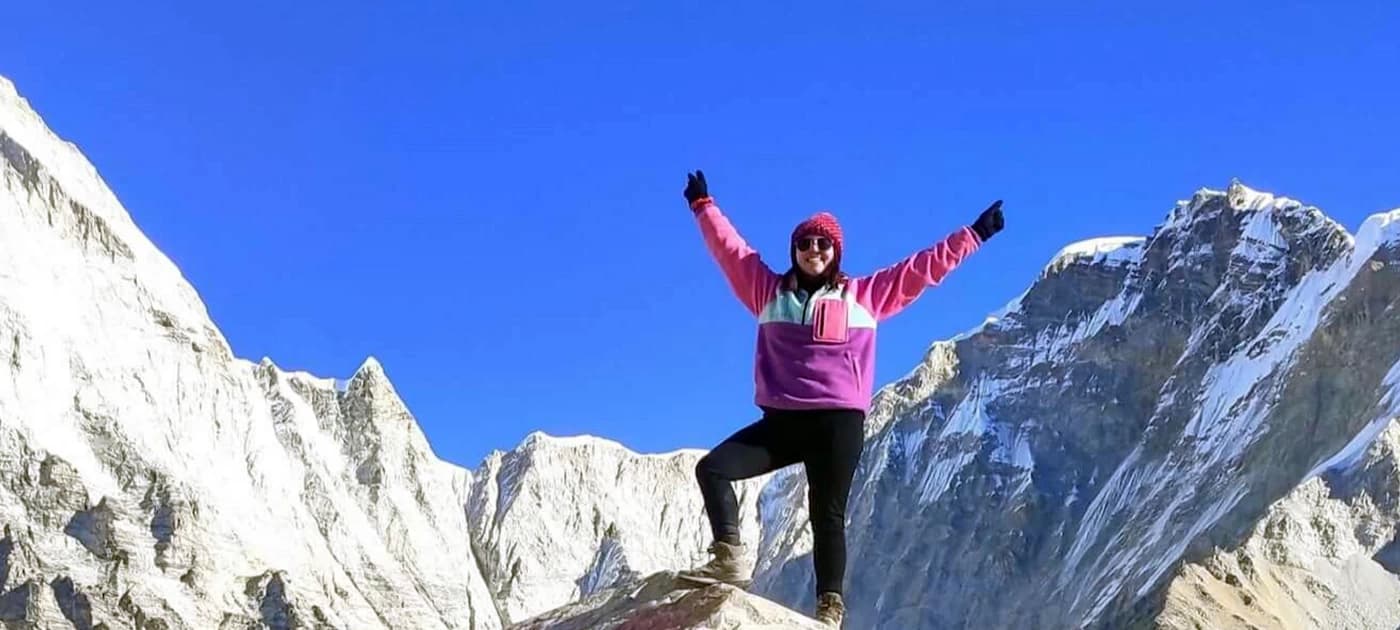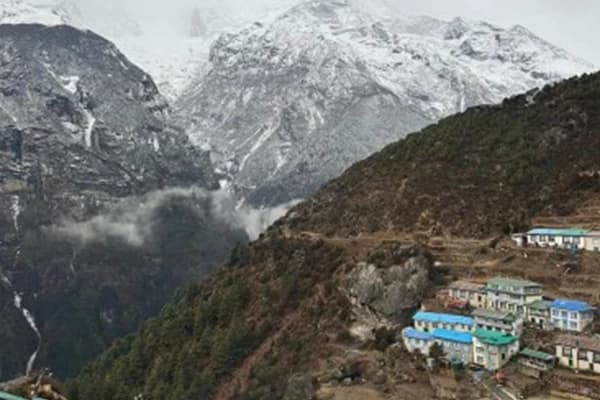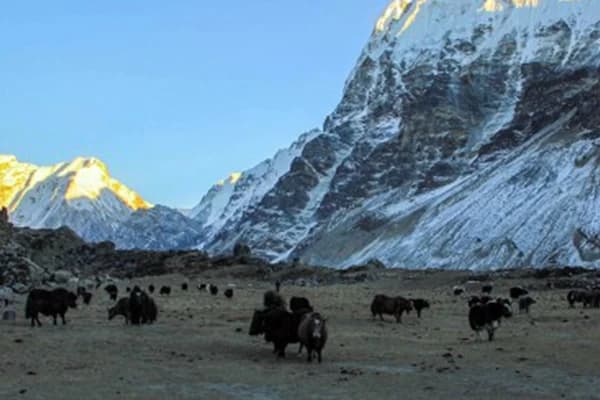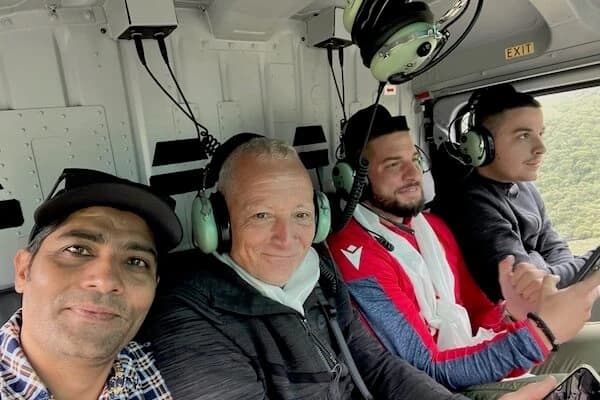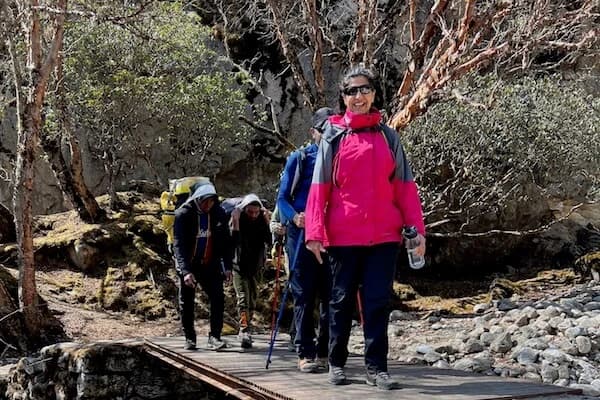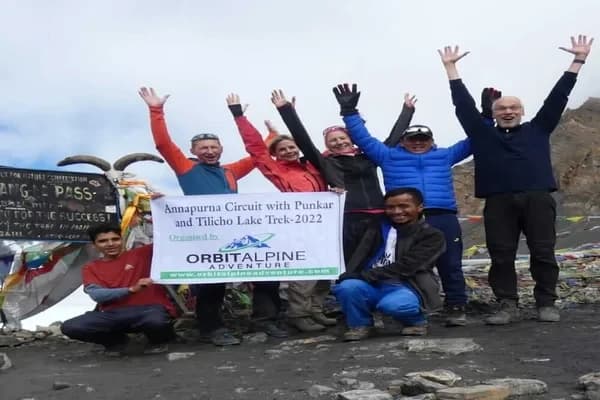The Everest Base Camp (EBC) trek with helicopter return is an extraordinary journey that mixes the excitement of walking through the royal Himalayas with the comfort and pleasure of a scenic helicopter flight back to Kathmandu. It is normally measured to be of moderate difficulty trek. This journey is a bucket-list experience for many, offering the opportunity to walk in the footsteps of fabulous mountaineers while taking in some of the most spectacular sceneries on Earth.
Best Time for Everest Base Camp Trek with Helicopter Return
The Everest Base Camp trek with a helicopter return is a perfect blend of adventure, culture, and convenience. It offers an unforgettable experience for those seeking a shorter and more impactful journey to the base camp of the world's highest mountain.
Beginning with a picturesque flight from Kathmandu to Lukla, the trip winds through attractive Sherpa villages, compact rhododendron forests, and crossways tall suspension bridges over glacial rivers. Explorers will witness all-around sights of high peaks, including Everest, Lhotse, and Ama Dablam, while progressively adjusting to the growing altitude.

The walk concludes at the iconic Everest Base Camp, located at the foot of the world’s highest mountain. Here, explorers can ace the Khumbu Icefall and soak in the exclusive atmosphere of this historic site. The journey reaches its acme with an exciting helicopter ride back to Kathmandu, providing an aerial view of the fabulous sceneries walked over the past few days.
Best Time to Trek to Everest Base Camp with Helicopter Return
Two Main Trekking Seasons
Pre-Monsoon (Spring) Season: Late March to Early June
Weather and Temperature:
Temperature: During the spring period, daytime temperatures at lower heights above sea level range from 10°C to 15°C (50°F to 59°F). At higher altitudes, including Everest Base Camp, temperatures can range from -6°C to 5°C (21°F to 41°F). In the night temperatures can drop knowingly, particularly above 4,000 meters, often dropping below freezing.
Weather: The climate during spring is comparatively steady, with clear skies and minimal rainfall. The risk of snowfall is less equated to the winter season, and the chances of bumping into heavy rainfall are nominal as the monsoon has not yet started.
Visibility and Scenery:
Visibility: This time of year offers brilliant visibility of the mountains, making it perfect for photography and attractive sights. The sky is naturally clear, providing fabulous views of Everest and other high peaks.
Scenery: Spring is known for its exciting rhododendron flowers. The lower valleys are decorated with colorful flowers, adding to the attractive prettiness of the trek.
Advantages:
- The climate is normally constant and auspicious for trekking.
- Perfect situations for helicopter flights due to vibrant skies and slight weather disturbances.
- Flourishing flowers improves the beautiful experience.
Disadvantages:
- The path can be packed as this is one of the most famous walking times of the year.
- Lodging and services may be more expensive due to high requests.
Post-Monsoon (Autumn) Season: Late September to Early December
Weather and Temperature:
Temperature: In autumn, daylight temperatures at lower heights range from 10°C to 15°C (50°F to 59°F). At higher altitudes, temperatures can vary from -6°C to 5°C (21°F to 41°F). At nighttime temperatures can be pretty cold, expressly as your method Everest Base Camp.
Weather: The weather is naturally steady and dry, with clear skies and slight rainfall. The monsoon rains have cleaned the air, ensuing in crisp, clear prominence.
Visibility and Scenery:
Visibility: Autumn is famous for its crystal-clear skies, offering some of the best sights of the Himalayan peaks, as well as Everest.
Scenery: The sceneries are spectacular, with the fresh vegetation from the monsoon season and the snow-capped peaks providing a spectacular difference.
Advantages:
- Brilliant visibility and constant weather surroundings make for a safe and pleasing walk.
- Perfect conditions for helicopter flights, confirming minimal disturbances and clear sights.
- The post-monsoon air is clean, pleasing to the eye the overall understanding.
Disadvantages:
- This is the demanding walking season, so expect crowded paths and teahouses.
- Prices for lodging and services can be more due to higher demand.

Off-Peak Trekking Seasons
While the pre-monsoon and post-monsoon seasons are the utmost famous times for the Everest Base Camp trek, some explorers prefer the off-peak times for numerous reasons.
1. Winter Season: December to February
Weather and Temperature:
Temperature: Winter temperatures can be awfully cold, with hours of daylight temperatures at higher elevations often below chilly and of the night temperatures reducing as low as -20°C (-4°F).
Weather: The climate is normally constant and dry, with vibrant skies. However, the cold can be powerful, and snowfall can make the path more demanding.
Visibility and Scenery:
Visibility: Winter offers exceptional visibility with vibrant, crunchy skies, providing open sights of the mountains.
Scenery: The scenery is covered in snow, creating a peaceful and original atmosphere.
Advantages:
- Rarer explorers on the path, providing a more lonely and peaceable experience.
- Fabulous winter scenes and clear sights of the mountains.
- Lower prices for lodging and facilities.
Disadvantages:
- Enormously cold temperatures can be stimulating, particularly at night.
- Some teahouses and facilities may be locked due to the low number of explorers.
- The risk of slides and icy paths can make the trek more unsafe.
2. Monsoon Season: June to September
Weather and Temperature:
Temperature: Daylight temperatures at lower heights can range from 10°C to 15°C (50°F to 59°F), while higher elevations will be cooler. At night temperatures can still drop knowingly.
Weather: The monsoon time brings heavy rainfall, mainly at lower heights. The climate can be changeable, with recurrent rain showers and possible landslides.
Visibility and Scenery:
Visibility: Visibility can be poor due to cloud cover and rain, concealing mountain sights.
Scenery: The scenery is luxurious and green due to the monsoon rains, with waterfalls and streams flowing lavishly.
Advantages:
- Very rare explorers, offering a more secluded experience.
- Luxurious green lands and fewer crowds.
- Lower charges for lodging and services.
Disadvantages:
- Hefty rainfall can make the paths slippery and risky.
- Bigger risk of landslides and flight withdrawals.
- Imperfect perceptibility of the massifs due to clouds and rain.
- Practical Tips for Planning Your Everest Base Camp Trek with Helicopter Return
Practical Tips for Planning Your Everest Base Camp Trek with Helicopter Return
Here are the practical tips for planning your everest base camp trek with a helicopter return.
1. Acclimatization
Irrespective of the season, proper adjustment is vital to avoid height sickness. Follow a steady ascent and permit rest days to adjust.
2. Physical Preparation
Train well beforehand to build your energy and strength. Cardiovascular exercises, hiking, and strong point working out will prepare you for the trek's physical requirements.
3. Packing Essentials
Pack suitable clothing for fluctuating temperatures and weather conditions. Layering is key to regulating varying temperatures. Important items take in a down jacket, thermal wear, walking pants, gloves, and a hat.
Good excellent walking boots, a backpack, and a sleeping bag valued for low temperatures are important.
Carry a first-aid kit, water cleansing tablets, and essential medications.
4. Booking in Advance
Book your walk and helicopter return in advance, particularly during top seasons, to confirm availability and lock in healthier rates.
5. Travel Insurance
Obtain complete travel insurance that covers high-altitude walking and helicopter withdrawal.
6. Local Guides and Porters
Hiring a local guide and porter can improve your trekking experience, provide valued understanding, and lessen the load of carrying heavy lots.
7. Permits
Confirm you have the compulsory permits for the trek, including the Sagarmatha National Park Permit and the TIMS (Trekkers' Information Management System) card.
Everest Base Camp with Helicopter Return Itinerary
This itinerary offers a complete guide to making the greatest of the Everest Base Camp trek with a helicopter return, confirming a memorable journey filled with natural beauty, cultural meetings, and personal attainment.
A comprehensive itinerary for the Everest Base Camp trek with a helicopter return, including daily distances, estimated trekking times, height information, and key tourist attractions for each day.
.jpg)
Day 1: Arrival in Kathmandu (1,400m/4,593ft)
Overview: Your journey begins with your entrance to Kathmandu, the lively capital city of Nepal. After landing at Tribhuvan International Airport, you'll be moved to your hotel. This day lets you rest and adjust to the local altitude while fixing for the trek ahead.
Activities:
- Moved to a hotel.
- Meeting with your walking guide.
- Sightsee Thamel, the busy tourist district.
- Last gear check and buying any last-minute materials.
Highlights:
- Undergoing the rich culture and history of Kathmandu.
- Go to see local markets and prepare for the walk.
Day 2: Fly to Lukla (2,800m/9,186ft) and Trek to Phakding (2,652m/8,700ft)
Overview: Early in the morning, you'll take an exciting 35-minute flight from Kathmandu to Lukla, the entrance to the Everest region. Upon landing, you'll start your trek towards Phakding.
Trekking Time: 3-4 hours
Distance: 8 km
Route Description:
The path inclines towards the Dudh Koshi River, going through pine forests and small Sherpa villages.
You’ll cross numerous suspension bridges and come across prayer wheels and main stones along the path.
Highlights:
- Picturesque flight to Lukla with spectacular mountain sights.
- First day of walking through beautiful landscapes.
- Overnight accommodation in a teahouse in Phakding.
Day 3: Trek from Phakding to Namche Bazaar (3,440m/11,286ft)
Overview: Today’s walk takes you to Namche Bazaar, the busy hub of the Khumbu region and the key trading center for the Sherpas.
Trekking Time: 5-6 hours
Distance: 10-12 km
Route Description:
The path follows the Dudh Koshi River, crossing it numerous times through high suspension bridges decorated with prayer flags.
You’ll walk through forests of pine and rhododendrons.
After entering Sagarmatha National Park, the path suddenly ascends to Namche Bazaar.
Highlights:
- Passing through the well-known Hillary Suspension Bridge.
- First sights of Everest and Lhotse.
- Sightseeing the exciting market of Namche Bazaar.
Day 4: Acclimatization Day in Namche Bazaar
Overview: To aid adjustment, you’ll spend a second night in Namche Bazaar, enchanting a day to sightsee the area and take in short hikes.
Activities:
- Trek to the Everest View Hotel for all-around sights of Everest, Lhotse, and Ama Dablam.
- Sightsee the Sherpa Museum and the Namche Monastery.
- Voluntary walk to Khunde and Khumjung villages.
Highlights:
- Remarkable sights of the Himalayas.
- Understanding Sherpa culture and climbing history.
- Go to see local bakehouses and shops in Namche Bazaar.
Day 5: Trek from Namche Bazaar to Tengboche (3,870m/12,694ft)
Overview: Today’s walk takes you to Tengboche, home to the biggest monastery in the Khumbu region.
Trekking Time: 5-6 hours
Distance: 10 km
Route Description:
The path offers remarkable sights of Everest, Lhotse, and Ama Dablam.
After descending to the Dudh Koshi River, you’ll climb sharply to Tengboche.
Highlights:
- Go to see the Tengboche Monastery, a mystical center for Sherpas.
- Fabulous sights of Ama Dablam, a well-thought-out one of the most gorgeous mountains in the world.
- Overnight accommodation in a teahouse in Tengboche.
Day 6: Trek from Tengboche to Dingboche (4,360m/14,300ft)
Overview: Today’s walk takes you above the tree line to Dingboche, a charming village enclosed by magnificent mountains.
Trekking Time: 5-6 hours
Distance: 11 km
Route Description:
- Incline through rhododendron forestry to Deboche and cross the Imja Khola.
- Climb progressively through grasslands and grounds to Dingboche.
Highlights:
- All-around sights of Ama Dablam, Lhotse, and Island Peak.
- Sightseeing the village of Dingboche.
- Adjusting to the higher height.
Day 7: Acclimatization Day in Dingboche
Overview: Another adjustment day helps your body adapt to the growing height. You’ll go on a short hike to improve adaptation.
Activities:
- Walk to Nagarjun Hill (5,100m) or Chukhung Gorge.
- Relaxation and sightseeing in Dingboche.
Highlights:
- Remarkable sights of Makalu, Lhotse, and other peaks.
- Witnessing daily life in a high-altitude Sherpa village.
- Easing and fixing for higher altitudes.
Day 8: Trek from Dingboche to Lobuche (4,940m/16,210ft)
Overview: Today’s hike takes you through a plain and stunning scenery to Lobuche, located near the Khumbu Glacier.
Trekking Time: 5-6 hours
Distance: 11 km
Route Description:
The path rises progressively, passing by the monuments of climbers who lost their lives on Everest.
Endure along the glacial deposit of the Khumbu Glacier to Lobuche.
Highlights:
- Sights of Pumori, Khumbutse, and further peaks.
- Shiny at the climbers' memorials.
- Attain the high-altitude settlement of Lobuche.
Day 9: Trek from Lobuche to Everest Base Camp (5,364m/17,598ft) and back to Gorak Shep (5,164m/16,942ft)
Overview: Today’s walk is the most awaited part of the trip, as you reach Everest Base Camp.
Trekking Time: 7-8 hours
Distance: 15 km
Route Description:
Walk to Gorak Shep, then continue to Everest Base Camp along the glacier.
After sightseeing at Base Camp, coming back to Gorak Shep for the night.
Highlights:
- Triumph Everest Base Camp and standing at the foot of the world’s uppermost mountain.
- Sightseeing the base camp area and soaking in the surroundings.
- Fabulous sights of the Khumbu Icefall.
Day 10: Hike to Kala Patthar (5,545m/18,192ft) and Helicopter Return to Kathmandu
Overview: A first-morning hike to Kala Patthar offers supreme views of Everest and nearby mountains. After walking downward to Gorak Shep, you’ll board a helicopter for an exciting flight back to Kathmandu.
Hiking Time: 2-3 hours
Distance: 4 km (round trip)
Flight Duration: 1.5 hours
Route Description:
Go up to Kala Patthar for sunrise sights.
Return to Gorak Shep and take a helicopter back to Kathmandu.
Highlights:
- Remarkable sunrise over Everest from Kala Patthar.
- Inflight sights of the Himalayas throughout the helicopter flight.
- Returning to the ease of Kathmandu.
Day 11: Leisure Day in Kathmandu
Overview: A well-earned rest day in Kathmandu lets you relax and replicate on your journey.
Activities:
Rest and easing.
Non-compulsory exploration in Kathmandu.
Highlights:
- Sightseeing Kathmandu’s cultural and historical places.
- Shopping for mementos and relishing local cuisine.
Day 12: Optional Sightseeing or Rest Day
Overview: An extra day for seeing the sights or rest, depending on your liking.
Activities:
Visit UNESCO World Heritage Places such as Swayambhunath (Monkey Temple), Pashupatinath, Boudhanath, and Patan Durbar Square.
Enjoy relaxation time in Kathmandu.
Highlights:
- Realizing the amusing history and culture of Kathmandu.
- Voluntary doings and personal easing.
Day 13: Buffer Day for Emergencies
Overview: This day is kept as a buffer in case of delays due to weather or other unexpected conditions during the walk.
Activities:
Flexibility to regulate plans as needed.
Highlights:
- Confirming a smooth journey with flexibility for any changes.
Day 14: Departure from Kathmandu
Overview: Your venture concludes with your parting from Kathmandu.
Activities:
Transfer to the airport for your departure flight.
Farewell to Nepal.
Highlights:
- Reflecting on a memorable trip through the Himalayas.
- Leaving with memories of the Everest Base Camp trek.
This complete itinerary confirms a well-rounded experience, matching exciting trekking days with adjustment and rest, all while importance the cultural and natural miracles of the Everest region. The helicopter return adds a comfortable touch, providing an exclusive view of the royal scenes hiked over the previous days.
Conclusion
Boarding on the Everest Base Camp trek with helicopter return is a once-in-a-lifetime venture that associates physical challenge, cultural immersion, and supreme natural beauty. This journey through the heart of the Himalayas offers an exclusive combination of experiences, from the exciting energy of active Namche Bazaar to the peaceful religiousness of Tengboche Monastery, concluding in the overwhelming presence of Everest itself.
The journey is not just about reaching Everest Base Camp, it’s about the complete experience. Each day on the path presents new views and opportunities to connect with the warm and welcoming Sherpa community. The adjustment process, while challenging, permits explorers to fully appreciate the magnificence of their environments and the suppleness of the human spirit in the face of nature’s excesses.
The helicopter return adds an unusual measurement to this journey. After the physical effort of the trek, the helicopter ride provides a swift and remarkable journey back to Kathmandu, offering inflight sights of the land crossed on foot. This combination of exploration and luxury confirms an unforgettable conclusion to the journey, departure trekkers with permanent memories and a sense of enormous achievement.
Scheduling this journey requires vigilant homework and thought of the best times to go, with the pre-monsoon and post-monsoon seasons offering the most favorable conditions. With the right groundwork, explorers can look forward to a safe and gratifying voyage.
The Everest Base Camp trek with a helicopter return is more than just a walk; it’s a heroic journey that will leave a permanent mark on those who accept it. The mixture of exciting paths, spectacular sets, cultural richness, and the excitement of a helicopter flight confirms that this trip remains engraved in the memory of every explorer.
some of the Available Treks are:
Everest Base Camp Helicopter Tour
Everest Base Camp Trek with Helicopter Return
Everest Three High Passes Trek
FAQs for Everest Base Camp Trek with Helicopter Return
1. What is the best time to trek to Everest Base Camp with a helicopter return?
The ideal times for the Everest Base Camp trek with a helicopter return are throughout the pre-monsoon (spring) season from late March to early June and the post-monsoon (autumn) season from late September to early December. These times offer a steady climate, clear skies, and the best trekking conditions.
2. How difficult is the Everest Base Camp trek?
The journey is moderately challenging, including long days of walking at high altitudes. It involves good physical fitness, stamina, and some previous hiking experience. Proper adjustment is vital to avoid altitude sickness.
3. Do I need previous trekking experience?
While previous trekking experience is helpful, it is not obligatory. However, good physical fitness and some skill with multi-day hikes will help you grip the trek’s demands.
4. How long does the trek take?
The journey classically takes 14 days, including adjustment days and a helicopter return to Kathmandu. This duration confirms a safe and pleasing journey, letting for proper adaptation to high altitudes.
5. What kind of accommodation is available on the trek?
Accommodation on the journey consists of teahouses, which are basic lodges offering simple rooms and common dining areas. While facilities are basic, teahouses provide important comfort and warmth.
6. What should I pack for the trek?
Key stuff to pack contains:
- Layered clothing for varying temperatures
- Good-quality trekking boots
- A warm sleeping bags
- Waterproof jacket and pants
- A hat, gloves, and sunglasses
- A first-aid kit and personal medications
- Water purification tablets
- Trekking poles and a backpack
7. What permits are required for the trek?
You need the Sagarmatha National Park Permit and the TIMS (Trekkers' Information Management System) card. These permits are normally organized by your trekking agency.
8. Is travel insurance necessary?
Yes, complete travel insurance is important. It should cover high-altitude trekking and emergency helicopter withdrawal. Confirm your policy includes these exact provisions.
9. Can I trek solo or should I hire a guide and porter?
While it is probable to trek solo, hiring a guide and porter is highly suggested for safety, local knowledge, and to boost your walking experience. A guide can direct the paths, provide an understanding of the local culture, and support in emergencies. A porter can carry your heavy load, permitting you to trek more easily.
